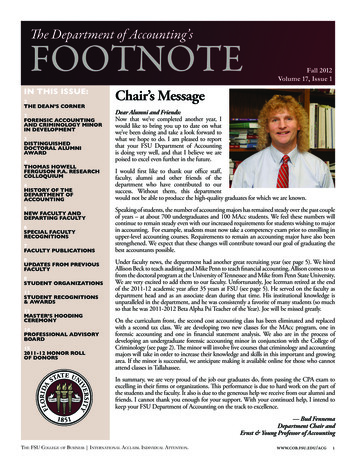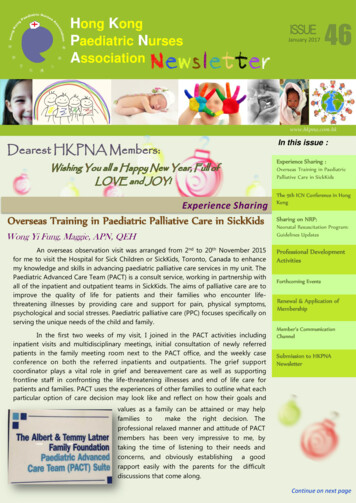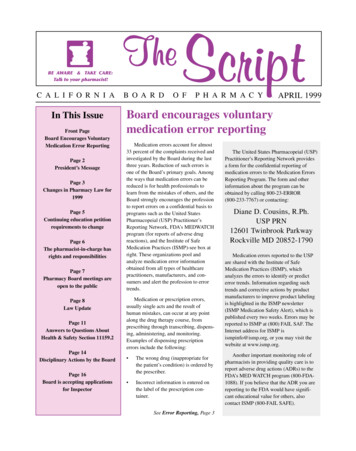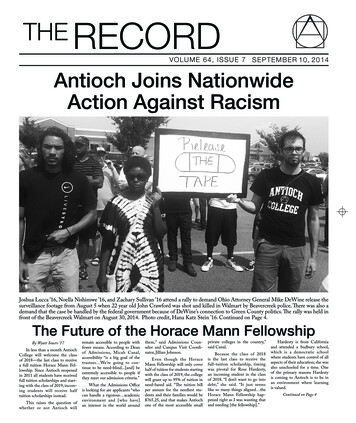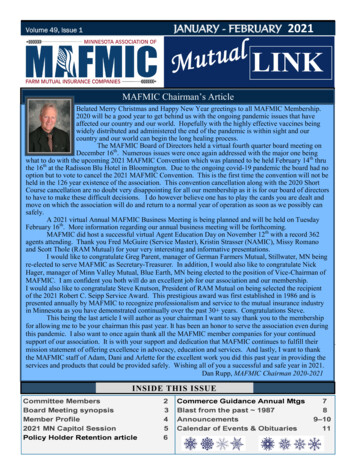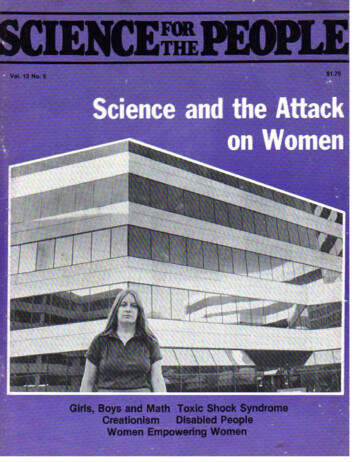
Transcription
about this issueThe topics of oppression, continued reactionarybacklash, and the important achievements of progressive groups are featured in this issue of Sciencefor the People. Two articles detail struggles of disabled people, an oppresssed group which rarelyreceives attention, even in this, the Year of the Disabled. The backlash inherent in such theories as scientific creationism and genetic inferiority receivescareful analysis in articles which point out thetheories' many weaknesses. The failures of industryand government to address the dangers of tamponsare examined. And in the face of recent attacks on theprogressive science movement, some important successes-the Boston Women's Health Book Collective,an international conference on radical science journals, and a conference on reproductive technology-are discussed and celebrated.More than most other groups struggling for socialgains, the lives of the disabled are intimately connected with their access to and control of scienceparticularly medicine and technology. Miriam Struck'sarticle criticizes the treatment and rehabilitationsystem for the disabled, showing how the very institutions dedicated to serving them perpetuate and evenmagnify the common negative stereotypes of the disabled. The author raises the need for twofold change:(1) greatly increased power of the disabled to set theirown rehabilitation priorities, and (2) political education of rehab workers on the realities of disabled people's lives. Finally Adrianne Aron reports on how disabled people in revolutionary Nicaragua have formed,a self-help organization providing supplies, counseling, job training, and active mutual support.Like the disabled, women have long been definedand limited by misconceptions about their physicalattributes. Women have been engaged in many effortsto redefine their positions in society and get control ofthe institutions which affect their lives. Barbara Beckwith's history of the Boston Women's Health BookCollective (BWHBC) celebrates the outstandingachievements of this group in educating and empowering great numbers of women on their health needsand rights. The BWHBC's successful political collective work is also valuable as an inspiration and modelfor other feminist groups.The need for more work on basic women's healthneeds is shown by Charlotte Oram and Judith Beck'shistory of the tampon industry in light of the recentexposure of toxic-shock syndrome. The authors showthat despite some changes in regulations of the most2dangerous products, the continuing hazards of amedical device used exclusively and almost universallyby women are hardly being dealt with by industry andgovernment agencies. Finally, Marian Lowe reviews abook relating the proceedings of a recent conferenceon women's reproductive issues. She gives an overview of the conference's topics and offers a critiqueof the political directions taken in related discussions,at this conference and elsewhere.To the immediacy of women's health issues is added a more abstract but crucially important issue.John Durkin and Jon Beckwith analyze the recentmedia furor over research studies which purport toshow that girls are inherently less able at mathematicsthan boys. The authors offer both opposing information to the widely publicized reports, and an analysisof why the attack on women is so virulent at the present time.Steve Gould, in his commentary on scientificcreationism, holds that although their scientific arguments are sometimes ridiculous, the fundamentalistinspired perpetrators of this movement can causeserious damage to progressive science. The author'sopinions and warnings come from a unique perspective, since his own widely known research on evolution has been misconstrued by scientific creationists assupport for their cause.Finally, Bruno Vitale reports and comments onlast April's radical science journals conference inItaly, at which Science for the People wasrepresented. He reaffirms basic goals of the radicalscience movement and the important role of publications such as SftP.This issue of Science for the People, as all otherissues, aims to provoke discussion, to raise controversy, and to inspire action. We want to receive readerresponses and opinions. In this new fall season, joinus in mutual support as we enter new and continuingstruggles around science and technology.UPCOMING ISSUES OFSCIENCE FOR THE PEOPLEThe SftP East Coast Editorial Committee is now soliciting articles for the March/April 1982 special issue on science andracism. Material should be sent to: BostonEditorial Committee, Science for the People,897 Main St., Cambridge, MA 02139.The SftP Midwest Editorial Committeeis planning a special issue on FeministScience for July/August 1982. They are seeking ideas, articles, review and commentaries.Material should be sent to: Midwest EditorialCommittee, Science for the People, 4318Michigan Union, Ann Arbor, Ml 48109.Science for the People
September I October 1981Vol. 13 No. 5GIRLS, BOYS AND MATHby Jon Beckwith and John Durkin6Why the media touts studies saying girls are mathematically inferior.BORN AGAIN CREATIONISMby Steve Gould10Another episode in the right's attack on science education.FEATURES:TAMPONS: LOOKING BEYONDTOXIC SHOCKby Judith Beck and Charlotte OramThe failure of industry and governmenthazards of tampons.to12address the healthWOMEN EMPOWERING WOMENby Barbara Beckwith19Updated history of a successful, inspiring feminist health collective."DISABLED DOESN'T MEAN UNABLE"by Miriam Struck24How the disabled confront attitudinal barriers of the rehabilitation system.DISABLITY, AFTER THE REVOLUTIONby Adrianne Aron29Dtsabled Nicaraguans initiate an independent living movement.Cover: Photo of a woman in front ofDraper Laboratory, a weapons researchfacility in Cambridge, MA, by RobertaNoris.DEPARTMENTS:INTERNATIONAL MEETING OF RADICALSCIENCE JOURNALSby Bruno VitaleAbout This IssueLettersNews Notes2Book Review4Reviewed by Marian LoweBirth Control and ControllingBirth & Custom-Made Chzld5ResourcesScience for the People is published bimonthly by the Science Resource Center,Inc., a non-profit corporation. The magazineis edited and produced by the national organization Science for the People. Our address is897 Main St., Cambridge, MA 02139; ourphone number is (617) 547-0370. We offer aprogressive view of science and technology,covering a broad range of issues. We welcome contributions of all kinds; articles, letters, book reviews, artwork, cartoons, newnotes, etc. If possible, please type manuscripts (double spaced) and send three copies.Be sure to keep one copy for yourself. Unlessotherwise stated, all material in this magazineis copyright 1981 by Science for the People.Typesetting at the mediaplace.September/October 198136Subscription rates (for one year/sixissues): 10 (regular), 14 (foreign surfacemail; for air mail add 4 to Latin America, 6.50 to Europe and 8.50 to Asia and Africa), 24 (institutional/library), 20 (member subscription), 10 (for people with low incomes). Member subscribers receive the magazine, our newsletter and other internal communications. Foreign subscrbers must remitin U.S. with either an International MoneyOrder or a check drawn on a U.S. bank.Bookstores may order on consignment directly from Science for the People or throughCarrier Pigeon Distributors, P.O. Box 2783,Boston, MA 02208. The magazine is availableon microfilm from Xerox Microfilms, 3002338North Zeeb Rd., Ann Arbor, MI 48109.Science for the People is indexed in Alternative Press Index, P.O. Box 7229,Baltimore, MD 21218. Science for the People's ISSN (International Standard SerialNumber) is: 0048-9662.Editorial Committee: (East Coast Collective)Hilary Anthony, Julie Gabaldon, Pat Gilroy,Terri Goldberg, Bob Hodap, Tony Iarrobino, Virginia Schaefer. Production Committee: Barbara Beckwith, Gert Freedman, MelFreedman, Ross Feldberg, Pat Gilroy, TerriGoldberg, Doug Hamilton, Andy Oien, SamPilato, Martha Robb, Virginia Schaefer, SueTafler, Ray Valdes. Distribution Committee:Alan Epstein, Chris Hydeman, VirginiaSchaefer, Clem Wang, Glenn Wargo. Staff·Terri Goldberg, Phil Stone.3
lettersGENETIC SCREENINGEditor's Note:Many companies have begun screening workers for susceptibility toworkplace health hazards recently.Research that shows genetic influenceson susceptibility to various poisons ispart of this trend, and raises seriousquestions about scientific ethics. Thefollowing letter concerns a reportabout one such study.This letter was sent to Science in response to one of their news articles.Science was not willing to publish it.We are printing it without modificationso as to point out the serious ethicalquestions involved in this kind ofresearch.Dear Science Editors:I am writing to comment on your account of the proposal to screen forcancer susceptibility by looking formutations in the gene coding forhypoxanthineguanine phosphoibosyltransferase (HGPRT).' As I understand it, people working in a factorywhere they are exposed to a knowncarcinogen (methyl chloroform, or1,1,1-trichloroethane) will be tested fortheir susceptibility to induced degenerative changes in their DNA. Thesepeople will then be monitored in orderto see whether those identified by thetest as susceptible will later developcancer. This monitoring would have tobe done over a long period of time,since cancer may take years to develop.A number of ethical questions cometo mind, concerning the workers involved, their families, their job securityand their working conditions. 1) Willthose workers identified as susceptiblebe so informed, and warned to leavetheir jobs, or will Dr. Shaw's groupwait until the last iota of proof is in,despite mortality which may result? 2)Will Dr. Shaw's group check forstillborn or malformed children as well,since methyl chloroform is known toproduce malformations, due probablyto its mutagenic activity? 2 Will explanations be given to those workerswho have had or will have malformedchildren? 3) Since the scientists involved are aware that methyl chlorofom ismutagenic and carcinogenic, will theyadvise the company to install properventilation, protection, etc., to reduce4the risks of cancer, despite the factthat the experimental conditions wouldbe thereby altered? 4) Will the resultsof this research be used to deny jobs topeople with "cancer susceptibility" ina time of high u1;1employment? 5) Willthe tests be used to permit employersto avoid reducing levels of carcinogensin the workplace by assuring workersthat susceptible people have beeneliminated?Science has published several articlesand papers recently on occupationalhealth and safety standards, in whichethical questions were raised. Theseissues should not be ignored whenpresenting science news items.Karen AI-AidroosProfessor of GeneticsMontreal, QuebecREFERENCES1. G.B. Kolata, Science, 207, p. 967, 1980.2. National Institute for Occupational Safetyand Health. Recommended Standard forOccupational Exposure to 1,1,1,-Trichloriethane. U.S. Department of Health,Education and Welfare. 1979.TECHNOLOGY IN INDIADear SftP:I have read and re-read Bandyopadhyay and Shiva's paper-"Westernor Indigenous Science," (SftP March/April, 1981) trying to find out whatthey wanted to say and how coherenttheir message was with Science for thePeople. I think now that what theywanted to say is, at best, obscure andthat the part which is explicit enough iscontradictory with the very basis of aradical social critique of science.There are sentences in the articlewith which it is impossible not toagree: "The characteristic of contemporary technological change in India isthat it is forced on people without theirconscious acceptance . " There are afew words of warning about the dangerof falling into a "nostalgic attempt torecreate the past." And then, we aretold that "the traditional systems ofscience and technology offer a set ofalternatives that are quicklyvanishing." So we expect concrete examples of these systems of science andtechnology. What we get is Ayurvedicand Yoga systems of health care, andtraditional fishing technologies.About traditional health systems theauthors state that, "the destruction ofthe social systems of indigenous medicine was not the result of its inferioreffectiveness in health care, which wasnever ascertained . Traditional systems, on the other hand, are decentralized and to a large extent allowbetter control by individuals over theirown health." Here are two points, oneof fact, one of principle: whoever hasseen (as I have seen, in Madras, and asthe authors have necessarily seen) people dying in the streets, unnoticed,quickly forgotten, cannot believe thatsuch a "system" was ever intended forcommon, working people-who hadfor centuries no health care at all (butfor dearly paid magic); who believes(as I do believe, and as the authorsprobably believe) that social institutions-as the health institutions andtherapies-are class-determined andideology-ridden, cannot see thisideological dependence only in westernmedicine and refuse to see it in traditional practices. Traditional practicesperpetuate the traditional class-castedivisions in India: only a few-Brahmins-know; no one knows fromwhich practice this knowledge comes,but one knows that it is imposed onthose who are victim to it. You candrink herb tea, instead of swallowing apill, and still be totally in the darkabout the origin and validity of thetradition that led to the use of thatherb, ignorant of its possible after effects .The authors state that "traditionallythe fishing community of India hasbeen satisfying the need for marinefood of the entire coastal region. Theyhave done so over the centuries, withtheir own technologies which wereecologically stable." This sentenceshould be read in the context ofanother sentence before it: "The indigenous scientific and technologicalframework which has supported the Indian people successfully . '' Thissounds very much like a sort of uncontrolled wishful thinking. I have visitedtraditional fishing villages south ofMadras in 1966, and they were literallystarving. Fishing was extremely poor,being restricted to a few hundred yardsfrom the shore-a catch would sometimes add up to a few pounds of fish,after the collective work of most of thevillage for hours. Selling fish was a bigproblem, partly because of the difficulty of conservation and partly becauseof local prejudices (huge posters inMadras proclaimed, vainly-itseemed-that "fish is not meat"). Is(Continued on p. 31)Science for the People
news notesFUTURE MOMS FORMX MISSILE"We want nukes/We want war?We think oil's worth fighting for!""Want do we want? Nuclear war!When do we want it? Now!"They were hardly the chants typically shouted on the Boston Common. But it was hardly a typicalbake sale that the chanters-TheFuture Moms for the MX Missile-were promoting early this summer. The treats offered to thelunch hour crowd included:Plutonium Fudge, Napalm Crackers, Trilateral Treats, AgentOrange Cake, Bombshell Brownies, and Apocalypse (out of thisworld) Muffins.Carrying placards reading, "Another Mother for World Domination" and "More Toys for theBoys," the six local feminists whoorganized the affair marched, sangand leafletted."We got the idea from the Vietnam era saying, 'It will be a greatday when the military has to holda bake sale to buy a bomb . '"said Marian Klausner, one of theparticipants.In all, about 350 people acceptedliterature detailing the 300 billioncost for the MX, and its power to"destroy Hiroshima 50,000 times." din the space of two hours, sixty signed a petition prepared bythe Council for a Nuclear Weapons Freeze, in Cambridge, callingfor a mutual U.S.-Soviet nucleararms freeze.The women are planning torepeat the "bake sale" at a laterdate. They will keep the samesponsors. The list includes: ThePeace Resisters League, Science forthe Corporate Interests, Union ofConcerned Capitalists, NationalAssociation for the AdvancementSeptember/October 1981of Rich People, National GrenadeOwners Assoc.-and, of courseMobilization for Extermination.-Liberation News Service,lnc.Copyright, 1981.EXPLOITING "NORMA RAE"Twentieth Century Fox has soldthe rights to the name ''NormaRae" to a non-union apparelmanufacturer, according to theClothing and Textile WorkersUnion.The manufacturer reportedlyplans to use the name on a newline of designer jeans. ACTWUUnion Label Director Del Mileskisaid the jeans will be marketed byKratex, a New York apparel firm.They will be produced by a nonunion contract shop in NorthCarolina, he said."It's ironic that a name that hasbecome synonymous with unionorganizing and the struggle forjustice will be exploited to makeprofits for non-union companies,"Mileski declared.Crystal Lee Sutton, on whoselife the movie, "Norma Rae" wasbased, said, "It makes me kind ofsad. They're just out for themoney."-PAl/The CarpenterCopyright, 1981.HIGH TECHNOLOGYPROFESSIONALS FOR PEACEHigh Technology Professionalsfor Peace is a recently formedBoston-area group of engineers,programmers and others sympathetic to the issue of getting hightech people out of defense work.High tech people are some of themost keenly aware of the destructiveness and wastefulness of military work. The group serves as asupport network for high techemployees concerned about militarism. It is working on outreach tothe large portion of engineeringpeople who are working on military projects, through choice ordesperation.The group, around 25 peoplenow and growing, is circulating apetition which endorses aU.S.-U.S.S.R. nuclear freeze, as away of attracting new membersand gaining publicity in order tobecome a national organization.An employment agency which offers defense industry employees acash incentive to change to nonmilitary work is the group's biggestproject now. The group also plansto do research on military-tocivilian industrial conversion. Youcan get in touch with High Technology Professionals for Peacethrough SftP or write:High Technology Professionals forPeacec/o American Friends ServiceCommittee2161 Massachusetts Ave.Cambridge, MA 02140Help Us Promote SftPContributions to Sciencefor the People's PromotionFund now total 1,000. Thissummer we have undertakensome major promotional mailings. We hope to continue ourpromotional efforts this fall,but we need your support. Wehave lots of ideas for promotion projects, now all we needis the money to do them.You can also help us byconvincing your friends andcoworkers to subscribe. If yousend us names of potentialsubscribers, we'll send thema complimentary magazineand promotional literature.Make your contributions toScience for the People's promotion fund now!! All donations are tax deductible. Senda check or money order to:Science for the People, 897Main St., Cambridge, MA02139.5
Science and the Attack on WomenGIRLS, BOYS AND MATHby Jon Beckwith and John Durkin"Are Boys Better at Math?" asked the December7, 1980, New York Times article. "Two psychologistssaid yesterday that boys are better than girls in mathematical reasoning, and they urged educators to acceptthe possibility that something more than social factorsmay be responsible." 1 On December 15, Time called ourattention to "The Gender Factor In Math": "Since therise of feminism . female underachievement in mathhas been generally chalked up to sexism . That theorymeets its strongest challenge yet in a seven-year studyreported in this week's Science magazine. According toits authors . males inherently have more mathematicalability than females. " 2 Newsweek headlined their articleon the subject, "Do Males have a Math Gene?" 3 And a' few months later, Discover magazine began its coverstory on "The Sexes and The Brain" with reference tothis same study as the most recent support for the posi.tion that sex-role differences are inborn. According tothe subtitle of this last article: "Men and Women thinkdifferently, Science is finding out why. " 4This is only a sampling of the extensive publicitywhich followed the publication of a stud
with's history of the Boston Women's Health Book Collective (BWHBC) celebrates the outstanding achievements of this group in educating and empower ing great numbers of women on their health needs and rights. The BWHBC's successful political collec tive work is also valuable as an inspiration and model for other feminist groups.


